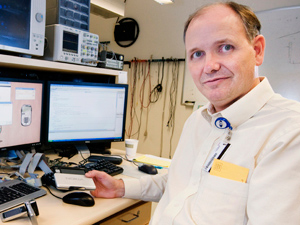Reps from Industry, Academia Meet to Discuss 'Fourth Generation' of Wireless Communications at Power Amplifier Symposium
San Diego, Calif., Oct. 2, 2009 — More than 120 representatives from both industry and academia joined forces at UC San Diego recently to discuss the challenges facing the wireless communications field, and how advances in power amplifiers (the device that increases the amplitude of cellular phone signals) might offer cheap, efficient solutions.
|
The Institute of Electrical and Electronics Engineers (IEEE) Topical Symposium on Power Amplifiers for Wireless Communications was held Sept. 14-15 at UC San Diego's California Institute for Telecommunications and Information Technology (Calit2). In attendance were engineers from various wireless communications companies, including Qualcomm, Panasonic, Nokia, RFMD, Alcatel/Bell Labs, SiGe Semiconductor, Freescale Semiconductor, Huawei, Nujira and Renasas. Universities from around the world also sent delegates, and a number of presentations (such as the paper co-written by engineers from Southeast University in Nanjing China and University College in Dublin, Ireland) indicated the high degree of cross-collaboration inherent to the field.
Calit2 Research Scientist Don Kimball, a participant in the symposium, noted that a primary focus of the discussions at the event was the "fourth generation" of wireless communications technologies, and how it might unfold.
"The first generation of wireless communications was 'terminal-to-terminal' — for example, Morse code and Western Union," Kimball explained. "Next came 'terminal-to-people' communications like radio and television broadcasting, and then people-to-people communications by way of cell phones.
"A hot topic at this symposium was the future of fourth-generation communications, and what that might look like. Will it be people-to-machine, machine-to-people, or machine-to-machine? The general consensus is it will be people-to-machine — you'll be able to program your DVR from your cell phone, for example. The technology already exists in Finland where you can turn on your sauna from your cell phone so it will be warm when you get home.
"In countries with a 'smart' power grid," Kimball continued, "we might use our cell phones to turn off our air conditioners once we've left the house, which would save a lot of energy. The feeling is that people-to-machine will be the 'killer app' of the next decade, and will be very big for wireless interfaces.
Other industry visionaries, remarked Kimball, think the future will be machine-to-machine communications.
"If your car knows where you are and thinks you're going home, it will turn on the A/C in your house for you," he elaborated. "You won't even have to be involved in the process. But machine-to-people is also a possibility — your kitchen plumbing might call you at work, for example, if it happens to go kaplooey."
Kimball and his colleagues note, however, that for any of these theories to become reality, several important advances must be made in wireless communications technology. Battery life for cellular phones is a big issue, for one: Applications, especially video applications, are becoming ever more data-intensive, and all that data sucks up a lot of power.
|
One proposed solution came out of the Calit2 Power Amplifier Lab, which is headed by Kimball. Detailed in a paper titled "A Digitally-Modulated SOI CMOS Asymmetrical Doherty Amplifier," the new method as designed by Calit2 researchers Kirchiro Nakatani and Sataporn Pornpromlikit calls for an inexpensive integrated circuit (IC) process for cellular phones and extended battery life, allowing users increased data/talk time before the power supply runs out.
Another UCSD paper presented by post-doc Calogero Presti ("A 2.4GHz , 24dBm SOI CMOS Power Amplifier with fully Integrated Output Balun and Switched Capacitors for Load Line Adaptation") calls for a stacked CMOS (Complementary Metal Oxide Semiconductor) power amplifier to achieve high power for wi-fi and a similarly inexpensive IC process.
Noted Kimball: "The interesting thing about this technology — besides the fact that it provides high-speed access — is that each transistor is on its own floating substrate. From the point-of-view of circuit design, we can develop novel circuit techniques based on this method of device stacking."
Another challenge in the wireless communications industry is environmental sustainability, especially in terms of electricity consumed by high power wireless base stations. One proposed solution, Kimball noted, is for higher power efficiency through rapid duty cycling, which allows the basestation to turn the transmitter off when it's not being used.
Another method for saving energy was detailed in a paper by Pyo-Yong Hong ("Two-Stage Envelope Tracking Power Amplifier for Basestation Applications") which proposes a means for improving 'gain' (and thus reducing power consumption) for high-efficiency power amplifiers in cellular base stations.
"And of course," Kimball remarked, "there's always price, price, price. Everyone wants their phones and basestations to be cheaper."
In his keynote address at the symposium, Electrical Engineering Professor Tom Lee of Stanford University noted that while the diet industry brings in a whopping $75 billion a year, current demand for the radio frequency integrated circuit power amplifier industry is only $2.5 billion.
"What this shows is that more people spend more money on very low-tech things like dieting and low-calorie foods than they on their cell phones," Kimball said. "Or in other words, it's an asymmetric use model — we spend more money trying not to do something (eating) than we spend on trying to improve our lives with our cell phones in a more cost-effective way. And that's even though people are probably spending more time interacting with their cell phone than they do eating. Or let's hope so, anyway."
Related Links
Institute of Electrical and Electronics Engineers (IEEE)
IEEE Topical Symposium on Power Amplifiers for Wireless Communications
Media Contacts
Tiffany Fox, (858) 246-0353, tfox@ucsd.edu


